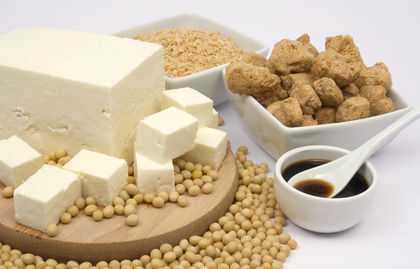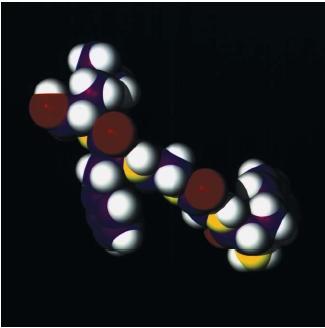Proteins

Proteins are very large molecules consisting of long chains of smaller units known as amino acids. Approximately two dozen different amino acids are used in the production of proteins. Suppose that we let the letter A stand for one amino acid, the letter B for a second amino acid, the letter C for a third amino acid, and so on through the two dozen amino acids. Then one simple way to represent a section of a protein is as follows:
-A-B-N-E-Y-W-C-K-S-R-I-A-J-B-D-S-K-H-S-E-H-C-A-I-E-F-M-Q-I-A-S-
This representation actually shows only one small part of a protein molecule. Most proteins are very large molecules that contain hundreds or thousands of amino acids.
What proteins do
Proteins are extremely important components of all living organisms. The word protein itself means "primary importance" because of the many essential functions of proteins in cells. Much of our bodies' dry weight is protein. Even our bones are about one-quarter protein. The animals we eat and the microbes that attack us are likewise largely protein. The leather, wool, and silk clothing that we wear are nearly pure protein. The insulin that keeps diabetics alive and the "clot-busting" enzymes that may save heart attack patients are also proteins. Proteins can even be found working at industrial sites. Protein enzymes produce not only the high-fructose corn syrup that sweetens most soft drinks but also fuel-grade ethanol (alcohol) and other gasoline additives.
Words to Know
Alpha helix: A type of secondary structure in which a chain of amino acids arranges itself in a three-dimensional spiral.
Photosynthesis: The process by which plants use light energy to manufacture their own food.
Primary structure: The linear sequence of amino acids making up a protein.
Quaternary structure: The highest level of structure found in proteins.
Secondary structure: Certain highly regular three-dimensional arrangements of amino acids within a protein.
Tertiary structure: A protein molecule's overall three-dimensional shape.
Within our bodies and those of other living organisms, proteins serve many functions. They digest foods and turn them into energy; they move molecules about within our cells; they let some substances pass through cell membranes while keeping others out; they turn light into chemical energy, making both vision and photosynthesis possible; they allow cells to detect and react to hormones and toxins in their surroundings; and they protect our bodies against foreign invaders.
Protein structure
The string of amino acids shown above represents only one level of protein structure, the simplest level. This structure is known as the protein's primary structure, and it is simply the linear sequence of amino acids in the protein.
All proteins have at least two more levels of structure. The amino acid groups that make up a protein all carry electrical charges. Those charges are responsible for the fact that some parts of the protein chain attract each other and other parts repel each other. The amino acid chain, therefore, always takes on some sort of three-dimensional structure. The most common of these structures is known as an alpha helix. Think of

what a Slinky™ toy or a spiral telephone cord looks like. Each of those structures is similar to an alpha helix. Many protein molecules have a similar three-dimensional spiral shape; this is known as the protein's secondary structure.
But proteins may take on even more complex structures. If you've ever played with a Slinky™, for example, you know that it can sometimes bend back on itself and twist into more complex shapes. The same can happen with protein molecules. The alpha helix secondary structure of the molecule can become bent and twisted into an even more complex shape, a shape known as the molecule's tertiary structure.
Some proteins have an even higher level of structure. One example is the protein known as hemoglobin. Hemoglobin makes up about a third of the weight of a red blood cell. It is responsible for transporting oxygen from the lungs to cells. Hemoglobin proteins have a quaternary structure in which four spiral amino acid chains are joined to each other through an iron atom in their midst.
Designer proteins
So-called "designer proteins" are synthetic (made in a lab) molecules invented by chemists to serve some specific function. At first, designer proteins were simply natural proteins in which modest changes were made by chemical reactions. These changes produced slight modifications in the physical, chemical, and biological properties of the protein.
For example, some proteins can be used as medicines, though they may also have undesirable side effects. By making small changes in the structure of the protein, chemists may be able to save the useful properties of the protein that make it valuable as a medicine while removing the undesirable side effects.
One long-term goal of many chemists is to design proteins from scratch. This process was still extremely difficult at the dawn of the twenty-first century and was expected to remain so until researchers better understood the way proteins form their tertiary structure. Nevertheless, scientists have been able to design a few small proteins whose stability or instability helps illuminate the rules by which proteins form. Building on these successes, researchers hope they may someday be able to design proteins for industrial and economic uses as well as for use in living organisms.
[ See also Amino acid ; Antibody and antigen ; Blood ; Enzyme ; Hormone ; Metabolism ; Nucleic acid ]